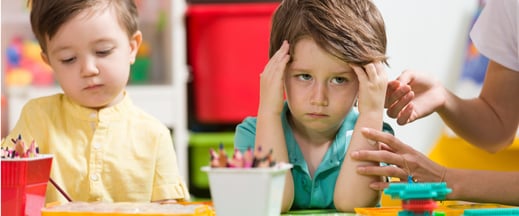
I was supposed to be an architect, instead I was a teacher of young children; it felt like my calling.
When I started my coursework, they tasked me with visiting multiple classrooms. It overwhelmed me when in some classrooms, children were crying, teachers were frustrated, and no one seemed to enjoy the day. I thought I had made a mistake. Thankfully, I had a professor who inspired me to continue. Instead of feeling overwhelmed by the behaviors I observed in both children and teachers, the professor charged me to uncover the root of those behaviors.
And so, my journey to support social-emotional development began.
The first and most critical skill I needed to heighten was empathy. I needed to put myself in the place of each child who was manifesting his or her distress through behaviors.
In my first year as a lead teacher, a 22-month-old boy cried at drop off. I held him against my heart and could feel how much he loved his family, his home, his toys, the smells of delicious foods, and delightful fragrances. I recognized that now he was in this new environment where nothing was familiar, not even me. I recognized his call for help - to help him accept this place as his by adding elements that would bring home to him.
When a young infant was crying inconsolably, which was rare. We tried holding her, patting her back, checking her diaper, offering her a bottle, and offering her preferred toys. When we uncovered those were not the cause of her distress, we then noticed that her little shoes were on the wrong feet. We switched them, consoled her, narrated the cause of her discomfort, and once again she was her happy, content self.
I vividly recall a preschooler who loved to build structures. We dedicated time to brainstorm and plan his structure, and then he would spend almost an hour building these intricate structures. When it was time to clean up, he would become very upset every single day. I recognized his behavior as his disappointment in needing to break down the structure he just worked so hard to build. There was a different class in the room in the afternoon, so he could not keep them up to return to the next day. To help him manage his distress, we implemented some proactive ideas. We prepared him for clean-up time, invited his mom to come in the room to see the structure and help clean up, and we took a picture to help him preserve the structure, and replicate it the following day.
My lessons from these experiences, supported by research, are that children often express their distress and unmet needs through various behaviors. Our role as a teacher is to help them in their journey of self-regulation.
In 2013-2014, I learned about Trauma Informed Care - the idea of viewing a child’s behavior through the lens of trauma and understanding the cause behind each behavior. Children who have suffered from neglect, any form of abuse, any form of high stress in their young lives, or other traumatic events come to our classrooms screaming: HELP!
When we pause and ask, “What may have happened to this child?”, we may not come to the definitive answer, but it will help us understand that the behavior is likely communicating a need. And often that need is love, safety, and trust.
We know that in order for children to relate to others and to learn, they first need to feel safe and welcomed.
It’s critical that social-emotional support becomes the foundational layer of care and education for all children, especially for those who have experienced adversity.
With that in mind, it’s clear to me that in the end, I am that architect I wanted to become. Rather than building homes, I’m an architect of young children’s brains.
The field of education is hard-work, and supporting children’s social-emotional development is even more difficult when we ourselves are experiencing adversity. It’s important to remember to put your oxygen mask on first. Find supports to help you stay connected, recharge, and maintain your own health. To support you on your journey of supporting children’s self-regulation, download our free resource guide that provides strategies for various behavioral cues. I hope you find them helpful in supporting you on your professional development journey.

